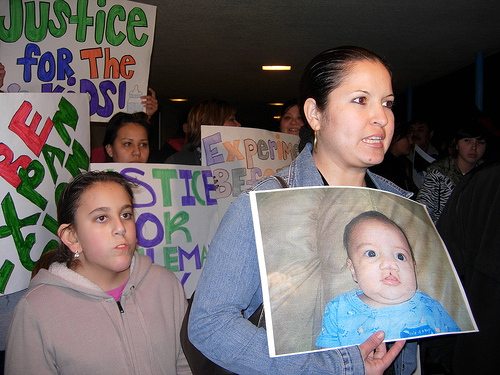
By: Vic Bedoian
Kettleman City has come into the focus of national attention in recent weeks. Over a 15-month period ending in 2008, six babies here were born with birth defects. Five died. It was an alarming development for the 1,500 residents of this western Kings County town existing at the intersection of factory farms, a major interstate highway and the Kettleman Hills hazardous waste landfill run by Chemical Waste Management.
From that time on, families and citizen groups cried out for an investigation, suspecting the toxic waste dump might be the possible cause. Finally, due in no small measure to coverage in the Los Angeles Times and the New York Times, everyone is listening.
Gov. Arnold Schwarzenegger ordered an interagency investigation led by the California Public Health Department (CDPH). Sens. Barbara Boxer and Dianne Feinstein pledged to block a proposed expansion of the toxic waste dump. Jared Blumenthal, director of the U.S. Environmental Protection Agency’s western region met with the afflicted families and promised a vigorous investigation.
In August 2009, Kings County officials asked the CDPH to help investigate the crisis. The CDPH issued a preliminary report on February 9, which was delivered to the county Board of Supervisors in the morning and to a community meeting that evening in Kettleman City.
The report looked at data on birth defects in the town and the surrounding region over a 22-year period. The primary conclusion was that the cause of the birth defects and infant deaths is still unknown. No patterns were found to suggest that there was a single underlying cause. The report also concluded that overall birth defects in Kettleman City were no higher than expected and that the birth defects could have been a chance occurrence.
Dr. Kevin Riley, chief deputy director for policy and public health, said the investigation is just beginning. There will be a combined effort by theCDPH and the state Environmental Protection Agency to measure and analyze all the health and environmental factors that might have a bearing on Kettleman City residents.
“Most importantly, [our task] is to continue to monitor births, to actively look at the 2009 data so that we can determine if the numbers in 2007-2008 were simply by chance. It’s critical that we continue to review that information and get the details on 2009 to try to get some answers for this community.”
The preliminary report was greeted with skepticism by residents and citizen groups who have been calling for a full-scale investigation of the Chem Waste facility. Bradley Angel of Greenaction for Health and Environmental Justice called the report “garbage” and questioned both the data and the methods used by the CDPH in compiling the report.
“We heard these so-called experts from the so-called Department of Public Health put out inaccurate information about there not being an underlying cause when they’ve never set foot in the town, never looked, never talked to the moms, when their so-called fact sheet just talked about things like alcohol and drug abuse–all the non-environmental factors which, if they had talked to the moms, did not apply. Most startling of all was their failing to mention the fact that all these babies had died.”
Kettleman City residents welcome the investigation but feel it is long overdue. Maricela Mares Alatorre, an activist with the local group El Pueblo Para El Aire y Agua Limpio (People for Clean Air and Water), criticized the supervisors for two years of inaction while residents were begging for a study of the birth defects. Her group, along with Greenaction and others, have filed suit against Kings County for what they consider a failure of oversight responsibility. Residents and environmental advocates remain to be convinced that public agencies will do a thorough job of finding out why the cluster of birth defects happened.
Government officials realize that the public spotlight is intensely focused on them now and insist they will expedite the multifaceted study. The CDPH researchers explain that there are many kinds of birth defects and that specific causes are difficult to pinpoint. Birth defects are the leading cause of death for children ages 0 to 10, with one child in 33 born with some sort of defect and one in 100 with a structural defect.
Researchers do not know the causes for most birth defects and think that each type of defect may have a different cause. One complicating factor in Kettleman City is that infants had different types of birth defects making it that much more complicated to find a common underlying cause. Dr. Kevin Riley cautioned that it is possible that a distinct cause-and-effect relationship may never be found.
The CDPH plans to issue another progress report in early March and keep the community informed throughout the investigation.
